U.S. Navy SEALs And The Hush Puppy
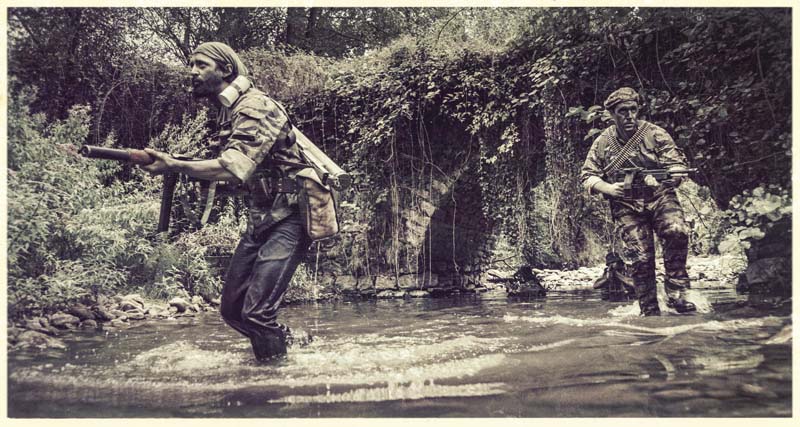
By Kevin Dockery
The suppressed firearm has somehow been considered “improper” for use in combat during World War II and after. Besides the obvious fact that the battlefield is an incredibly noisy place and a suppressor would simply be another piece of equipment to be lost, a silent shot killing a lone enemy trooper is somehow “unfair.”
The only organizations to really use suppressed weapons were the British and American intelligence agencies, respectively the Special Operations Executive, (SOE) and the Office of Strategic Services (OSS). The British saw the value of a suppressed weapon and even had a suppressed submachinegun, the Sten Mark II S (Silenced) as well as the DeLisle suppressed bolt-action carbine, the Welrod twist-action suppressed pistol, and the Sleeve Gun, a single-shot device that slips up the sleeve and is fired with a pull-cord.
On the American side, we had the High Standard Model H-D .22 pistol with an integral suppressor. Another common suppressed weapon in the OSS arsenal was a suppressed barrel that could be screwed-on the standard barrel of any .45 ACP M3, and later M3A1, submachine gun. And while the suppressed .22 pistol would seem a relatively weak combat round, the intent of the weapon was to be able to kill an enemy quietly without anyone at a distance being able to tell that a gun had been fired.
The suppressed M3 and M3A1 submachineguns were indeed combat weapons, but so quiet that anyone nearby would have a very hard time telling from where a shot had come. Though the ported barrel reduced the velocity of the already slow. 45 ACP rounds, the heavy bullet would still impact very hard on a target. And, the fact that a burst could be fired, made certain that a target could be eliminated relatively quickly and quietly.
However, these weapons almost ceased to exist in the post-war years. Even with the creation of the CIA from the OSS, the use of suppressed weapons was something “not spoken of.” The practicality of their use was recognized, but by only by a relative few in the intelligence communities. Combat was not something intelligence officers were supposed to get involved with. But when there was a desperate fight in the shadows and alleys between agents from both sides, the suppressed pistol shot could end things very quickly, and it was only the victor who walked away.
The most active arena for post-war intelligence agents was, of course, Eastern Europe and Germany. These areas had been a hotbed of combat, some of it hand-to-hand, in the closing months of World War II. In post-war Europe, German weapons were relatively commonplace— abandoned, lost, or captured during the war— and these guns were nearly impossible to connect with a specific group or individual. For this reason, the CIA developed a suppressor that could be used with the Walther P-38 pistol, a 9mm double-action pistol that was considered one of the more advanced handguns to come out of World War II.
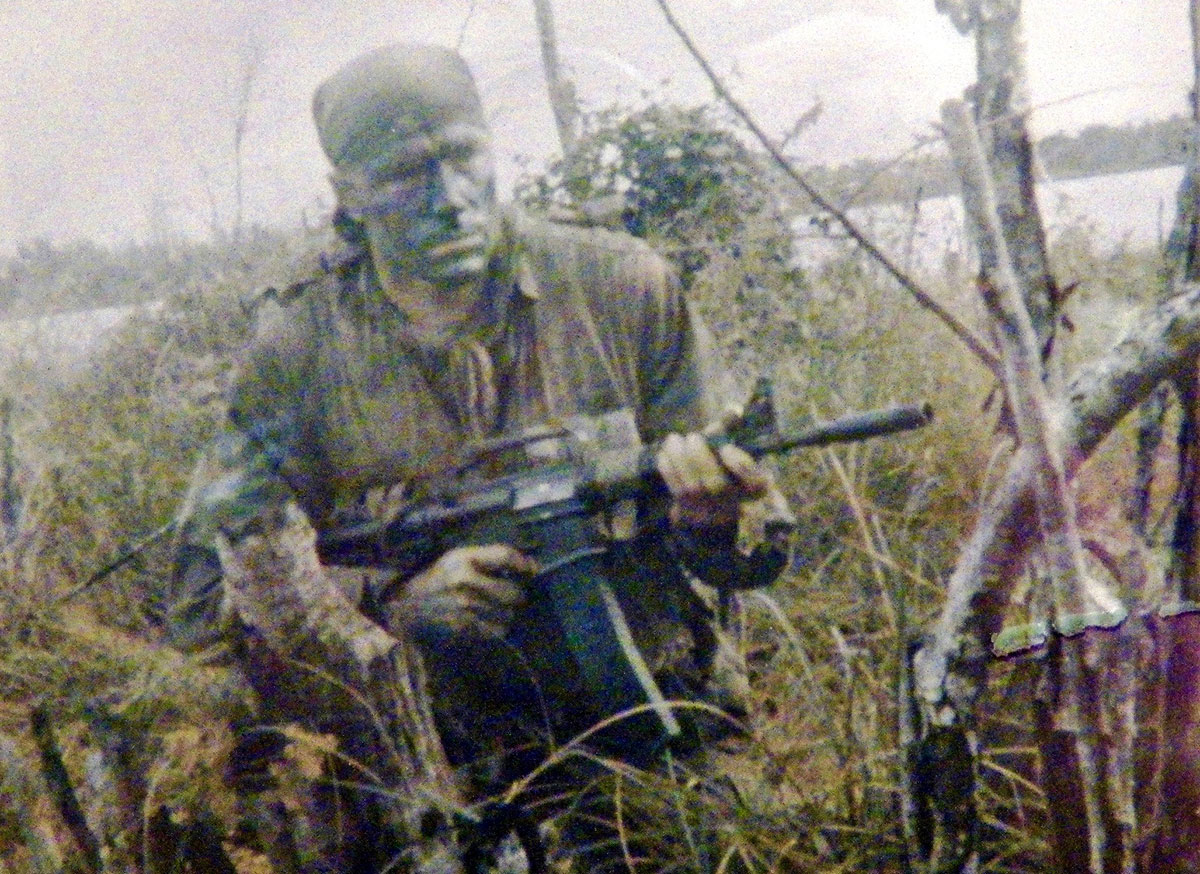
CIA Silenced Pistol Kit
In 1958, the CIA began issuing a “Silenced Pistol Kit.” The kit consisted of a grey plastic case that could easily pass as a camera case. Inside the top of the case was a complete suppressor (called a “moderator” at the time) along with a threaded P-38 barrel. In the bottom of the case was a box of 50 rounds of 158 grain 9mm subsonic ammunition as well as a cleaning rod and small bottle of oil.
The CIA suppressor was a wipe-type silencer. In the front of the can was a replaceable capsule containing five polyurethane wipes, each with an “X” cut into its center. The wipes were held in a can about 3-inches long. The balance of the 5.7-inch suppressor acted as an expansion chamber.
The wipes would wear out as bullets passed through them. After about 50 rounds had been fired though the suppressor, the wipe capsule had to be replaced.
A later model of this suppressor was developed by the West Germans. In addition to equipping a P-38 with a silencer, the West Germans added a slide lock on the side of the receiver. The lock would hold the breech shut when the weapon was fired to prevent the slide from cycling and making collateral noise.
The original CIA kit only required a P-38 pistol in order to be of use; the later West German variation had a dedicated receiver with the slide lock built in.
It is interesting to note that the original CIA kit came with instructions to the shooter. These included an admonition to recover any empty brass casings that had been ejected by the weapon. This was because the casings could be traced or identified as having come from a specific weapon, a P-38, because of the breech face markings being impressed into the fired case. To complete the covert work, the instructions said to remove the suppresser with its threaded barrel and replace it with the original barrel.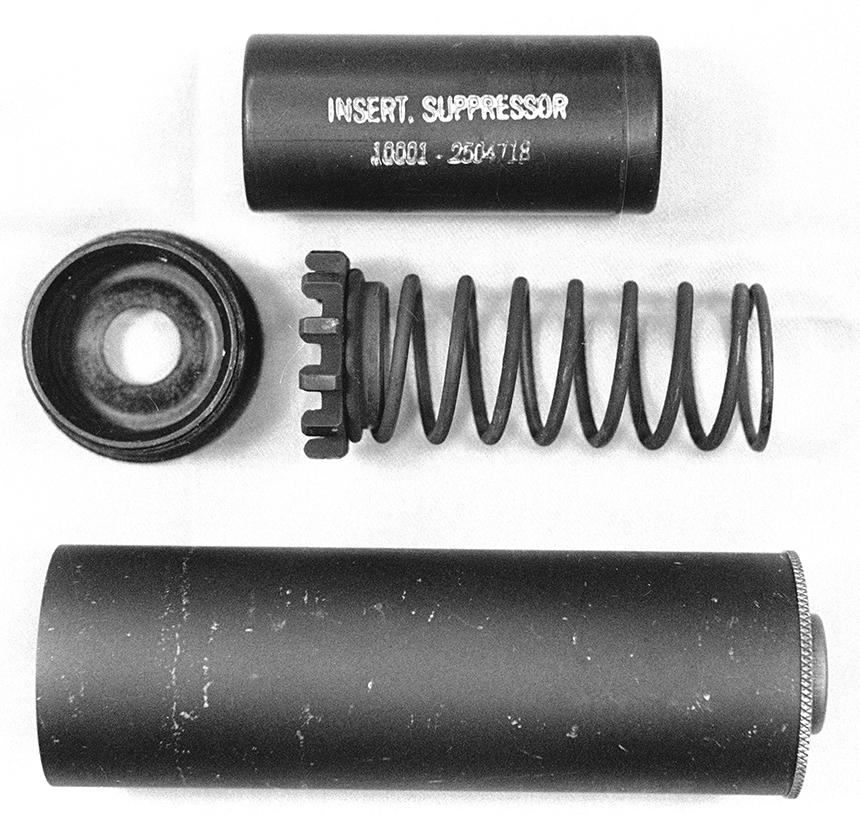
The subsonic ammunition supplied with the CIA suppressor had a heavy bullet of 158 grains, as compared to the normal 9mm bullet of 115 or 124 grains. With a properly developed load, the heavy bullet would be fired with a muzzle velocity below the speed of sound. The subsonic projectile would not have a sonic “crack,” the noise made when supersonic projectiles pass through the air, particularly when the accompanying shock wave passes an object.
The West German suppressed P-38 system was brought to the attention of Navy firearms engineers at the Naval Surface Ordnance Center, White Oak, Md. That’s when things got interesting.
U.S. Navy SEALs
When the U.S. Navy SEALs were commissioned in 1962, one of their mission tasks was that of intelligence gathering. They would be operating in a clandestine manner, well behind enemy lines, deep in hostile territory. Part of their operating arsenal would have to include a suppressed weapon, but there were few available at the time. The one gun that was available in some numbers was the suppressed M3A1 submachinegun from the OSS.
The suppressed M3A1, commonly called the “Grease Gun” due to its resemblance to the automotive tool, was a fairly heavy weapon as it stood. This was particularly important because the SEALs were expected to swim to a target when the mission called for it. With the suppressor barrel screwed into place and a 30-round magazine loaded, the M3A1 tipped the scales at over 11 pounds with each additional loaded magazine adding over 2 pounds to an operator’s load. Overly heavy and cumbersome, the Grease Gun was the only suppressed weapon available to the Teams at the time, and it did see some duty in Vietnam.
Obviously, other weapons besides silenced subguns were needed by the SEALs, including a handgun. Although the .45 caliber M1911A1 pistol was the standard issue handgun for most of the U.S. military at the time, the SEALs wanted something different. What the Teams wanted originally was a revolver, specifically the Smith & Wesson Model 19 Combat Magnum, a .357 Magnum. The open design of the revolver would allow water to quickly drain from the barrel and action when a swimmer breeched the surface. Additionally, the magnum round could disable equipment, such as smashing outboard motor engines.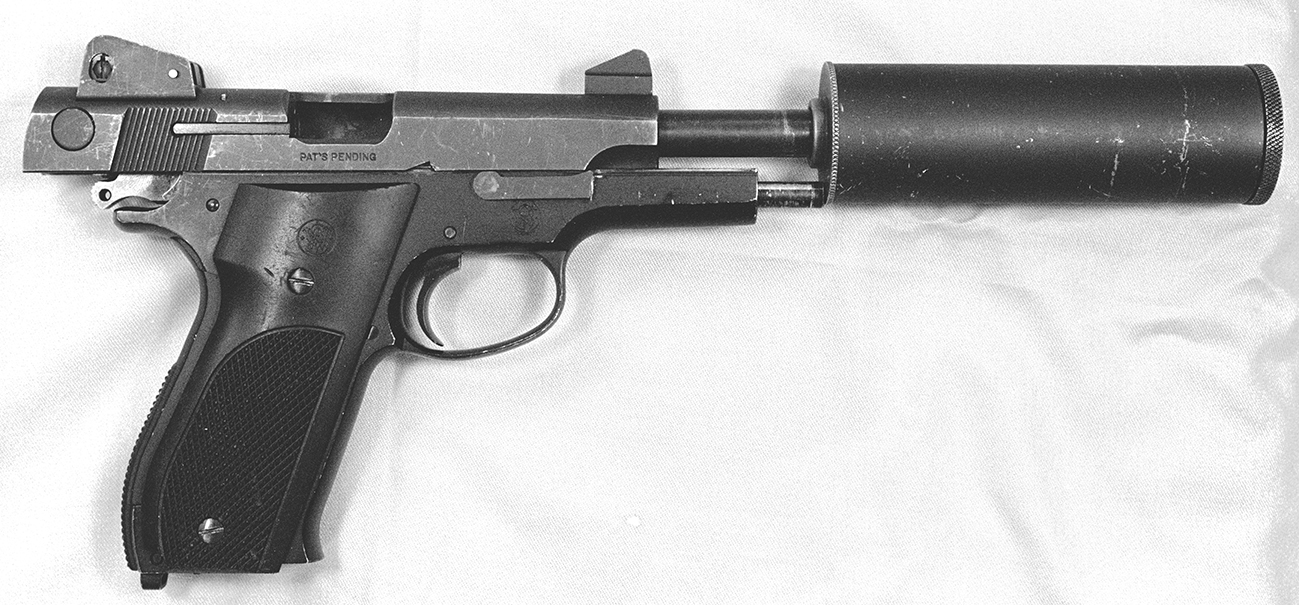
In one of those pathetic yet laughable mistakes, a supply officer made an error and instead of ordering the Combat Magnum (Model 19), the order was placed for Combat Masterpiece (Model 15). The Model 15 is a .38 Special, still a revolver, but much less powerful than the magnum!
The semiautomatic handgun the SEALs wanted would be different than the M1911A1. That weapon was considered to have heavy recoil and required too much valuable training time to truly master. The U.S. military had been considering a possible replacement for the M1911A1 for some years, but it would be decades before the decision to replace the venerable warhorse service-wide would be accepted.
Enter The Model 39
In the early 1950s, the Smith & Wesson designed a new pistol for possible use by our military. This weapon was chambered for the popular 9 Luger cartridge, found in worldwide use for both pistols and submachineguns. The new Smith & Wesson pistol was the Model 39, a lightweight handgun due to an aluminum alloy frame. The firing mechanism was a doubleaction. The hammer could be manually cocked to single-action or the trigger could be pulled through double-action. If by chance the chambered round did not fire, the trigger could be pulled again, raising and dropping the hammer a second time.
The Model 39 was a very accurate handgun straight out of the box. Smith & Wesson brought out several commercially-successful match pistols based on the general design of the 39. But when the Model 39 was submitted for government testing in 1954, it was not considered a suitable replacement for the M1911A1. Smith & Wesson then offered the pistol for commercial sale and to progressive police agencies.
In the 1960s, the Navy looked to the Model 39 as a possible replacement weapon for their combat pilots. The Navy had been issuing six-shot revolvers to their pilots for a long time. The appeal of the Model 39 was that it was lightweight and it also held two more rounds of ammunition in its magazine than a revolver held in its cylinder. And as a semiautomatic, it would be much faster to reload than a revolver.
As things turned out, the Navy did not accept the Model 39 for issue to its pilots, but the official examination and testing of the weapon brought it to the attention of the SEALs who were then entering into combat in Vietnam. (The first Direct Action platoons from SEAL Team Two were sent over to Vietnam in 1966.) The S&W Model 39 had just arrived at the Teams prior to the platoon deploying. After working with the weapon, individual SEAL operators were allowed to chose which handgun they would prefer, the Model 15 Combat Masterpiece .38 Special or the Model 39. The Model 39 was chosen as the preferred sidearm by a number of SEALs, and it remained a pistol in the Teams for years afterward.

The SEALs preferred a 9mm handgun to a revolver because ammunition was widely available throughout the world. As part of their mission profile required clandestine operations in foreign countries, the .45 ACP round would stand out, announcing that Americans had been there.
In spite of their general satisfaction with the Model 39, there was an aspect of the weapon most SEALs disliked— the magazine safety. When a magazine was removed from the weapon, the pistol could not be fired. This was considered a safety feature. If the magazine was removed, but the round in the chamber not cleared, the weapon could not be fired. A fine feature for civilian use, but the SEALs were very highly trained and not likely to make such a mistake. Though officially discouraged, a number of SEALs had the magazine safety removed from their pistols.
SOG Connection
A number of organizations operating in Vietnam and Southeast Asia made use of the SEALs for their field operations. One of these agencies was the Military Assistance Command, Vietnam— Special Operations Group (SOG). Later changed to the Studies and Observation Group, the acronym remained the same, MACV-SOG. This organization ran a large number of intelligence gathering operations throughout Vietnam, including Long Range Reconnaissance Patrols (LRRP) deep behind enemy lines and prisoner-snatch operations, even going across international borders for high-value targets or intel. SEALs would be attached to MACV-SOG whenever their skills were needed for a successful operation.
MACV-SOG worked closely with the intelligence communities in the United States. They had access to information, equipment and weapons that were otherwise very difficult to come by. Stealth was a major factor in SOG operations. Small groups of men operating behind enemy lines could not afford to be discovered. When they did run into enemy forces, they had to either extract as quickly as possible or quietly eliminate the enemy when there was only one or two of them. Suppressed weapons were of great value in such situations, but they were in limited supply. One of the weapons that MACV-SOG had access to traced its origins back with the OSS of World War II, the High Standard Model HD suppressed .22 pistol.
The High Standard Model HD started as a target pistol and was always known for its accuracy. It was also relatively light and very handy to use. The suppressor for the pistol had been developed beginning in January, 1943 at the Bell Telephone Laboratories in New York. The suppressor was a steel tube, 1 inch in diameter, that extended 2.5 inches past the muzzle of the pistol’s 6.69-inch barrel. The barrel of the pistol was turned down to a slightly smaller diameter with four rows of 11 holes (1/8-inch diameter) drilled into the bore. Between the body of the barrel and the tube of the suppressor was a wrapping of wire mesh. In front of the muzzle, extending to the end of the suppressor, was a stack of mesh washers with a central hole. An end cap on the muzzle held the stack of washers in place.
In November, 1943, production of the suppressed High Standard pistol began and several thousand were made before the end of World War II. Such a useful weapon is rarely scrapped and the suppressed High Standards remained in use for decades. The SOG grabbed what they could.
An aspect of all of the holes being drilled in the barrel— a total of 44 ports—was that standard velocity .22 long rifle ammunition would leave the barrel at subsonic velocity. Even “high velocity” ammunition was tamed by the highly ported barrel to subsonic speed. There was no sonic crack from the weapon.
 The High Standard was still very accurate, which helped make up for the rather weak .22 round. The High Standard, in the hands of a competent marksman, could place all of its rounds within a very small target, even as small as an eye, at 10 feet or less— and the SEALs tended to be very competent marksmen. The weapon was highly valued by the SEALs who used it, but they wanted more.
The High Standard was still very accurate, which helped make up for the rather weak .22 round. The High Standard, in the hands of a competent marksman, could place all of its rounds within a very small target, even as small as an eye, at 10 feet or less— and the SEALs tended to be very competent marksmen. The weapon was highly valued by the SEALs who used it, but they wanted more.
German Influence
The Navy had been working on suppressed pistols even as the SEALs were sending Direct Action platoons to Vietnam. In Fiscal Year 1966, the Naval Surface Ordnance Center in White Oak, Md. was running a project to develop a suitable suppressed pistol for the Teams.
The West German P-38 suppressor was the starting point for the Navy’s silencer. In the German design, flexible plastic wipes were held in a small aluminum canister. The canister was installed at the front of the suppressor body and held in place by a spring. This design allowed for an expansion chamber just in front of the muzzle of the weapon, giving the initial muzzle blast a place to dissipate slightly. The bullet would travel through the suppressor capsule, making a path as it went.
With the capsule held tightly at the front of the suppressor body, the propellant gases had no place to exit the system except through the wipes of the capsule. This suppressor capsule design also allows the suppressor as a whole to be serviced by the operator. All one had to do to replace worn suppressor wipes was to remove the old capsule and replace it with a new one.
To cut back on the sound of firing a P-38 even further, the Germans had put a slide lock on the side of the pistol. The slide lock would be worked by the operators thumb and pushed up to engage a raised lug with a cutout in the slide of the weapon. Firing the pistol with the slide lock engaged eliminated almost all of the mechanical noise of firing— the hammer fall and primer initiation were the loudest sounds of firing.
By pressing the slide lock down, the operator could work the slide by hand, reloading the pistol for another shot. If semiautomatic fire was desired, the operator just left the slide lock in the down, unlocked, position. At that point, the pistol would fire a slightly noisier shot for each pull of the trigger.
The general design of the suppressed P-38 pistol had been proven to be a sound one by the engineers at White Oak, but more importantly, the P-38 validated the idea of a locked breech, manual-repeater to be practical. The next major step was to adapt the design to an American weapon, preferably one that was already in use by the Teams.
Only one American handgun fit the requirements for fitting with the German-style suppression system, the S&W Model 39.
Noise Suppressor Mark 3 Mod 0
With the Navy’s general design of a new suppressor based on the German can, next came modifications to the Model 39. The mounting of the actual silencer was a simple matter. A new barrel was made for the Model 39 which extended the normal 4-inch barrel to an overall length of 4.75 inches with the last half-inch of the extended barrel threaded to ½ x 32 tpi.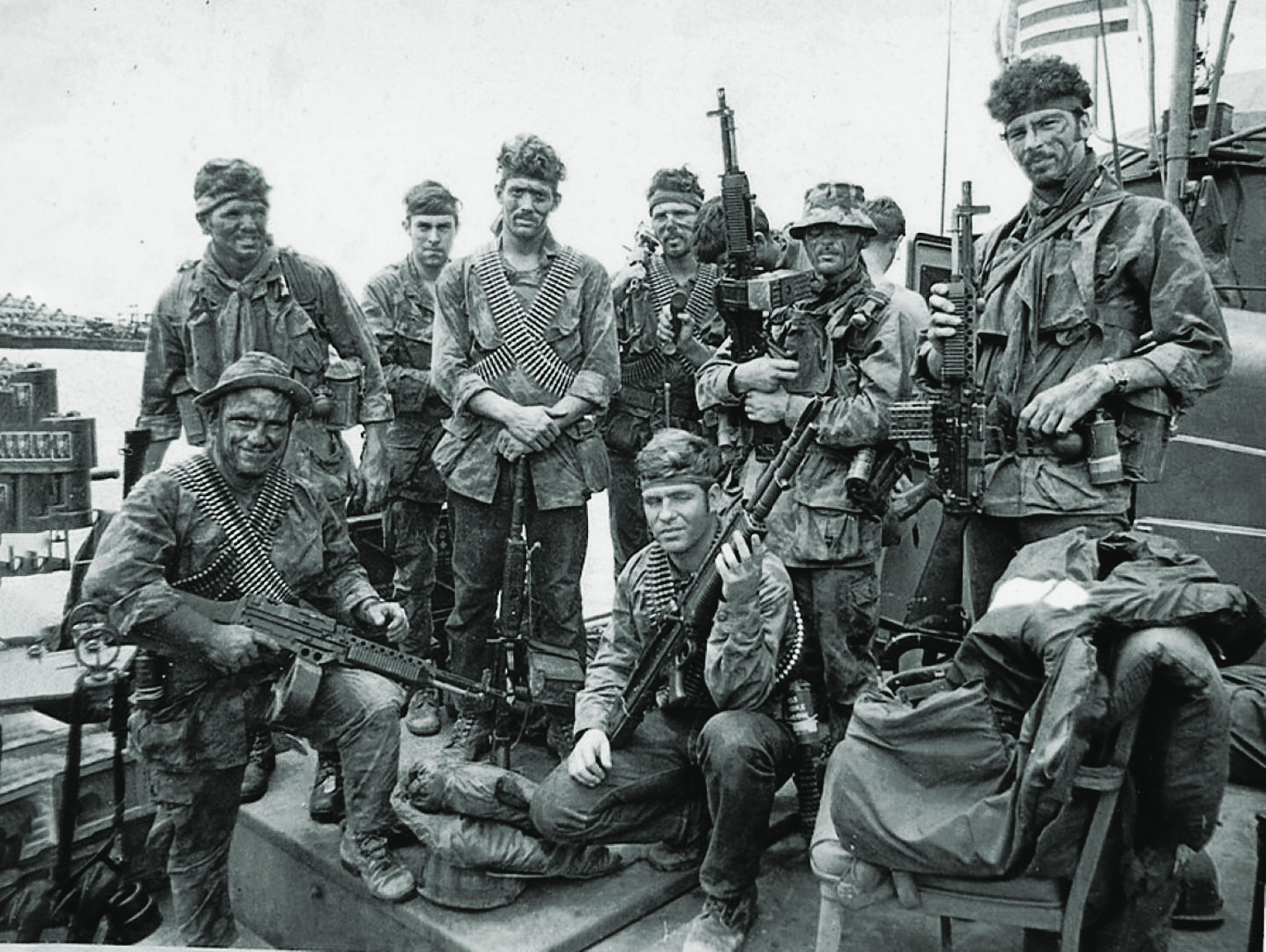
The Model 39 uses a Browning short-recoil locking system. The slide and barrel are locked together by a single lug on the barrel and a second locking surface on the front of the barrel hood. These surfaces engage with matching surfaces on the slide and prevent the slide from separating from the barrel until the gas pressure from a fired cartridge has dropped to a safe level. The slide recoils a short distance when the underside of the barrel engages a camming surface on the frame of the pistol and tilts, or drops down. The camming action forces the rear of the barrel down, unlocking it from the slide. The slide continues to the rear from the force of recoil, compressing the mainspring which will then drive it forward to strip a fresh cartridge from the magazine, chamber it and go into lockup again.
The barrel movement is minimal, but the barrel must tilt downwards to unlock the action. This movement requires that the design of any suppressor be very light so that the locking system can operate with the extra weight on the end of the barrel. Accordingly, the White Oaks suppressor design called for the body and most of the parts to be made from aluminum alloy.
One other change to the original German design was needed for the SEALs— waterproofing. Both ends of the suppressor were sealed with the addition of a neoprene O-ring. There was also a chamber plug. The development of the Navy’s experimental suppressor was conducted under the name “WOX-1A gun silencer.” When type-classified for issue to the Teams, it was designated as the “9mm Noise Suppressor Mark 3 Mod 0.”
Further modifications were made to the Model 39 to make it suitable for issue. The 39 uses a barrel bushing to hold the front of the barrel in place. It is much easier to replace a worn barrel bushing than a slide if the weapon loses accuracy from wear. This is the same system as used in the M1911A1 pistol. The bottom of the rotating barrel bushing is held in place by the front pin of the recoil spring guide. This was eliminated. Instead of the bushing, the front of the Model 39 slide was machined to have a guide hole for the mainspring guide, and also to have a solid front to the slide with only a very slightly oversized hole for the barrel to pass through.
To lock the slide when the pistol was fired, turning the pistol into a locked-breech, manually operated, single-shot, a slide lock assembly was attached to the weapon. Modifications to the slide were minimal with only two notches for the locks machined into the slide, just ahead of the right-side slide stop notch. The slide stop itself was highly modified with a long lever attached by a castle-nut on the right-end of the slide stop pin. The rear of the left-side locking lever had been extended far enough back so that it could be operated by the shooter’s thumb, being pressed down to lift the front locking surfaces into place on the slide.
The normal slide stop plunger and spring were included to keep the lever from moving unintentionally. On the other side of the slide stop pin was a second locking lever extending towards the muzzle of the weapon. Both locking levers would move simultaneously. Other modifications to the Model 39 were the removal of the magazine safety and the replacement of the wooden grip panels with black plastic grips.
To keep the sight line above the suppressor body when it was attached to the pistol, a high front sight blade was brazed onto the slide. For a taller rear sight, the micrometer-adjustable sights from the Smith & Wesson Model 52 match pistol were installed.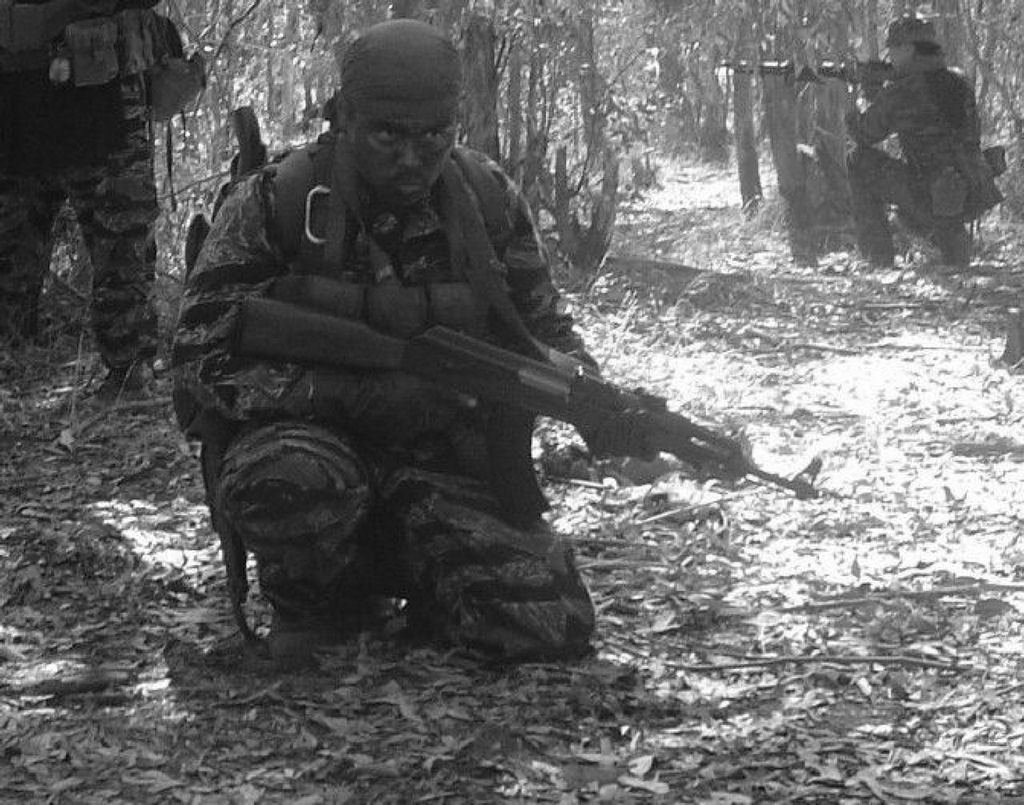
Subsonic Ammunition
Along with the modifications to the Model 39 and its wipe-style suppressor, special subsonic ammunition had to be designed and produced for the weapon. The previous CIA-issued round was used as the starting point and the loads were worked-up at White Oak.
At the time, there were effectively no heavyweight 9mm bullets on the market., but there was a ready source of full metal jacketed .38/.357 bullets available. The difference in the .357” diameter to that of the .355” 9mm bullet, only .002”, was a simple matter of a sizing die pass. And as the project developed, proper bullets for the ammunition would become available. Remington Arms assisted in the adaptation of a 158 gr. FMJ bullet to a subsonic 9mm load.
The load gave the proper subsonic velocities through a five-inch pistol barrel. The final specifications for the ammunition was that it has a projectile weight of 158 grs., with a tolerance of 2 grs. The major requirement of the round was its velocity. Final specifications were that the ammunition must have a velocity of 965 fps at a distance of 15 feet from the muzzle. The velocity of the ammunition could not deviate more than 25 fps while the maximum velocity of a single round could not exceed 1,045 fps.
The new ammunition needed to have the same recoil impulse as the standard 124 gr. FMJ 9x19 round, which had been issued since World War I. This requirement was necessary so that the new ammunition could function a 9mm handgun while not having excessive pressure. The ammunition had to be accurate. The requirement was that eight consecutive shots would be fired from a 9-inch test barrel, locked firmly into a firing fixture and all of the bullets would land within (or cut the edge) of a 6-inch circle at 50 yards.
Possibly one of the most unusual requirements for acceptance of the new ammunition was that it be waterproof. Cartridges had the primer annulus and bullet at the case mouth sealed during manufacture. Rounds were tested from a lot of ammunition (10,000 to 35,000 rounds) by being placed in a container and submerged underwater. The container would be pressurized to 100 psi above atmospheric pressure and held at that pressure for at least 1 hour, after which time, the round would be test fired. This pressure was later lowered to 30 psi, equivalent to 67 feet of depth, to reduce the possibility of failure to fire to less than 1 percent. The pressure was chosen as it is past the maximum safe depth for underwater swimming with a pure oxygen rebreather, such as used by the SEALs and UDT at the time.
The rounds were adopted as the Mk 144 Mod 0 9mm Ammunition and was issued specifically for use by the Naval Special Warfare Groups as noise-suppressed ammunition for the Mk 23 Suppressor Kit. Identified by a green bullet tip, the Mk 144 Mod 0 ammunition was produced initially by the Super Vel Cartridge Corporation of Shelbyville, Ind.
Mk 22 Mod 0
The Smith & Wesson Model 39 was accepted for issue as the Mk 22 Mod 0 9mm pistol, the Mk 22 Mod 0 marking replacing that of the Model 39 on the left side of the weapon, just above and ahead of the trigger, directly below the serial number. Issue of the weapon system included the Mk 22 Pistol, Mk 3 suppressor, a special extended waterproof polyurethane belt holster that held the pistol (with the suppressor attached) along with an extra magazine in an exterior, snap-down, flapped pouch. The holster had a metal belt clip for attachment to the issue military pistol belt, as well as a belt loop to hold the holster on a standard uniform belt. The bottom of the holster was open to drain water.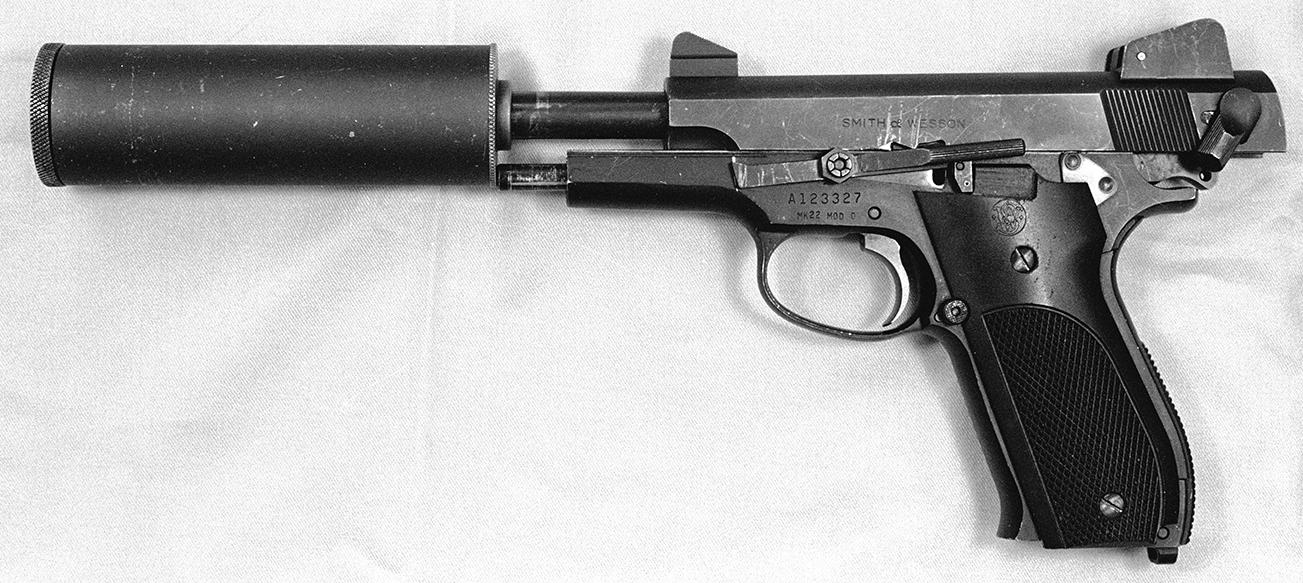
Included in the basic issue of the Mk 22 pistol were a few small parts, specifically a standard slide stop lever (to replace the slide lock lever system) and an ejector depressor and plunger. Replacing these parts converts the Mk 22 back to S&W Model 39 specifications.
Waterproofing materials were designed for use with the Mk 22 pistol and the Mk 3 suppressor, mounted or unmounted on the weapon. Plastic disks, roughly the size and shape of poker chips, were “muzzle plugs” that could be snapped into the front of the suppressor. When used on the Mk 22 with the suppressor attached, the muzzle plugs were completely safe for the operator to simply shoot through. A back end cap plug would seal the rear of the suppressor when it was carried separately from the pistol.
A barrel cap was supplied to go over the threaded portion of the pistol barrel. It could also be safely fired through, if necessary. For the chamber, a chamber plug was supplied, roughly the same size and shape of a 9mm cartridge. A central O-ring around the body of the chamber plug helped it seal the barrel of the pistol when carried underwater. The waterproofing materials would allow the pistol to be safety transported underwater to a depth of 200 feet.
All of the waterproofing materials, the pistol, suppressor, spare parts, extra magazine, and a small container of grease, were packaged in styrofoam supports and placed in an M19A1 steel packaging can. The resulting package was the “9mm Pistol & Suppressor Kit, Mk 23 Mod 0, NSN 1385-021-5137.” The pistol without the suppressor was the Mk 22 Mod 0, but with the suppressor mounted on the barrel, it was the Mk 23 Mod 0, but most operators called the Hush Puppy.
Mk 26 Accessory Kit
The Mk 22 pistol and the Mk 3 suppressor required specialized ammunition (subsonic 9mm, Mk 144 Mod 0) as well as a maintenance parts kit to keep the weapon functioning at maximum efficiency and sound reduction. To supply the required ammunition and parts in the field, the Navy adopted the Mk 26 Mod 0 Accessory Kit. The kit was issued as a unit: all the components were contained in a Styrofoam box, 4 7/8 inches long, 3 1/16 wide, and 1 1/2 inches thick. Sealed together with tape, the two halves of the kit would open up along the width and length of the case. Nested in individual holes cast in the two halves of the case were 24 rounds of Mk 144 Mod 0 ammunition. In a central groove in the case was an O-ring to seal an end-cap of the suppressor body. There were also six Muzzle Plug disks, four Chamber Plugs, one Barrel Cap, and one Back Cap Plug. The largest single piece of the kit was a new “Insert, Suppressor.”
Since the suppressor insert would wear out when the weapon was fired, the insert had to be replaced on regular intervals. Once the weapon had fired 24 rounds of Mk 144 ammunition (three magazines full) the insert was considered worn out— time to insert the new suppressor insert along with the necessary ammunition.
Team Service
In late 1967, the Mk 22 started being issued to the Direct Action SEAL platoons deployed to Vietnam. The new weapons were still partially in the developmental stage, but they were so in demand by the SEALs that they were being issued as soon as they were available. In the early days, only a few pistols were available for issue, however, with a few years, the availability of the weapon increased considerably.
Very quickly following the issue of the new weapons, controversy arose regarding the use of suppressed weapons in combat. “When we originally asked for a suppressed pistol, ThePowers-That-Be did not want it called a silencer. We were asked what we wanted it for. Since the idea of killing men with a suppressed handgun was somehow ‘unsportsmanlike,’ we told them that the weapon was wanted to shoot dogs. Every Vietcong village had some dogs hanging around that would sometimes bark when we approached. Since [we said] the weapon was intended to silence dogs, and any other vermin who happened to get in front of it, the pistol was named the Hush Puppy,” a member of Team 2 said.
The Hush Puppy pistol and suppressor were manufactured by Smith & Wesson at their factory in Springfield, Mass., starting in 1967 and continuing until sometime in the early 1970s. The Navy had shown interest in an experimental pistol produced by Smith & Wesson in 1964. These pistols— there were only two made— were a conversion of the Model 39 to accept a Browning Hi-Power magazine. The Navy then issued a contract to Smith & Wesson to produce 10 new pistols along the lines of the Mk 22. The pistols were to be made of stainless steel and have the same modifications, long barrel, slide lock, etc., as the Mk 22. The contract was worth $33,000.
It took Smith & Wesson 18 months to produce the 10 weapons because of the way their production lines were set up. The new pistols were fitted with removable shoulder stocks, something that was not available for the Mk 22. Special grip inserts were made that would allow the stocks to be attached to the earlier Mk 22 pistols, but these were rarely seen. The new weapons were not accepted by the Navy for issue. Later, Smith & Wesson introduced the pistol with its double-stack magazine as the Model 59.
Smith & Wesson ceased manufacture of the Model 39 in the early 1980s, with the last one being shipped in 1983. The company had ceased manufacture of the Mk 22 in the early 1970s with the winding down of the Vietnam War. By the 1980s, the Mk 22 weapons still in active SEAL hands were starting to wear out. Of particular notice was the locking notches on the slide. They would gradually crack under extended use and such weapons had to be pulled from issue. Further spare parts were not forthcoming from Smith & Wesson.
But the suppressed handgun had well proven its value in the jungles and waterways of Southeast Asia. The Hush Puppy would be long remembered as one of the most famous weapons ever fielded by the U.S. Navy SEALs.
